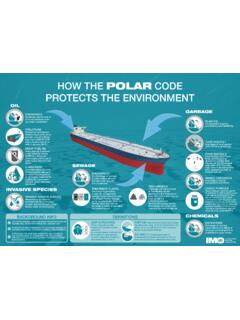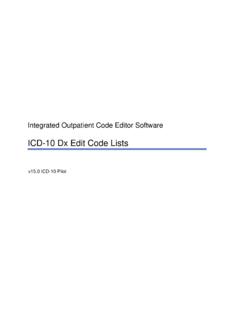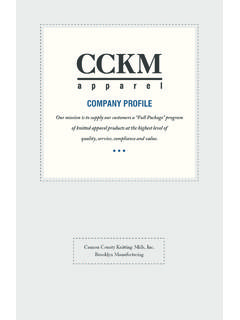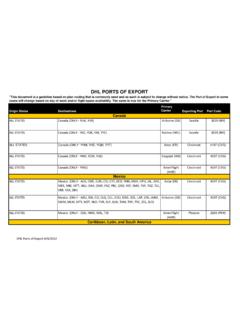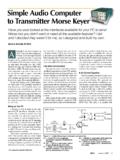Transcription of harishvictory gmail - Resources on Polar Codes
1 The Documentation ofPolar Codes in MATLABA MATLAB package in the field of Error Control CodesbyHarish the supervision ofProf. Emanuele Viterbo and Dr. Yi Hong,Software Defined Telecommunications Lab,Dept. of Electrical and Computer Systems Eng.,Monash University, Clayton, VIC 3800, you find any sort of bugs in code/documentation, please report A Quick Installation .. Quick basics .. Illustrations and Tables ..22 The More Detailed Channel Selection .. The Plotting Utilities .. Encoding/Decoding/Code-Construction Functions (Basic Modules).
2 Micro-scale Functions .. 103 A Discussion on the Algorithms The Encoding .. The Decoding .. The Code Construction .. The Use of Log-domain calculations .. 14 Bibliography15iiPrefaceThis is the full documentation of a MATLAB package dedicated to help simulating the Polar Codes invarious channel models such as a binary symmetric channel (BSC), a binary erasure channel (BEC), andan additive white Gaussian noise channel (AWGN).The package focuses to provide the most fundamental blocks related to Polar Codes , to aid researchersstart working with Polar Codes right away.
3 The package is expected to save a significant amount ofvaluable time required to develop modules related to Polar Codes such as encoding, decoding, code-construction, and performance analysis such as plotting FER/BER importantly, the package provides an implementation of greater efficiency to the users whichis tested, benchmarked, and improved over a long period of time. As we find, the only way to see anysignificant improvement in the speed of the routines in this package is to rewrite them in a lower levelprogramming language such as C/C++, with a similar care has been taken to provide the users a code with detailed comments and help written all overso that they can easily build over the modules.
4 During the writing of this code, a significant importancehas been given to be concise and user-friendly. The result is a very small, portable package of fullyreadable matlab files that you can easily download from the below Quick InstallationThe MATLAB package is openly available at below is the enhanced online resource of our earlier site at: , hosting the code along side of the other tutorial videos and many otheruseful Resources related to Polar installation of the package is achieved by probably the simplest way possible.
5 Just copy the fewsource files (extracted from the zip file) to a your local preferrably, adding the location of the extracted files to the matlab spath(File Set Path Add folder) will allow the user to use the modules from any working Quick basicsHere is a matlab package, that you can start using right away to work with Polar Codes , by simplycopying them on to your hard drive (see Section ).More specifically, the packages allows you the following fundamental Choice of the three popular channels: BEC, BSC, and AWGN2.
6 Polar encoding3. Polar decoding4. Polar code construction5. Plot the performance curvesFinally, it is made sure such that all the above will only empower the users to upgrade the package andbuild more advanced simulation environments for their research with Polar a quick illustration of what this package is capable of doing, we will simply show some pictures,tabular forms, and cheat sheets in this chapter. An impatient user should be able to start right away bysimply reading a couple of diagrams in this the next chapters, we will provide a traditional and complete documentation of the package, whichwill unleash the full features of the package for a more advanced Illustrations and TablesThis section contains several illustrations to help understand the architecture of the package quickly andstart using it immediately.
7 In the next chapter we will provide a detailed and complete Fig. describes a mind-map of what constitutes this package. It also describes the functionalcomponents of Polar Codes . The terms universal and non-universal refer to the dependence of codestructure on the channel conditions. If the code structure is changed everytime the channel conditionschange (by running the code-construction again), then the code is called a non-universal code. If thecode is not changed with channel conditions, then it is called a universal Fig.
8 Describes a division of the package into two categories: the basic routines and the derivedroutines. It is a very convenient division to understand the , the Tables and quickly describe all the main routines and their arguments that a usershould be interested in practice. A more detailed and complete documentation of the same along side ofmany more utilities will be given in the next Codesin MATLAB(BEC,BSC,AWGN channels)CodeConstructionBounds onBhattacharyyaparamsMonte-Carloestimati onTal&Vardy sestimationGaussianapprox forAWGND ecodingSuccessivecancellationdecodingLis tDecodingMLDecodingEncodingMatrixmultipl icationO(N2)Butterflycircuit modelO(NlogN)SystematicencodingPerforman ceAnalysis(FER/BER)As auniversalcodeAs anon-universalcodeAs asystematiccodeFigure.
9 The overall conceptual structure of the MATLAB package(parts in gray are unavailable, may be available in future versions)2 Table of Functions(Note: Arguments inunderscored italicsare optional)Family of Basic UtilitiesinitPC(N,K,channelname,channels tate,silentflag,frozenbits)x = pencode(u,myfrozenlookup)u = pdecode(y,channelname,channelstate,myfro zenlookup)x = systematicpencode(u,myfrozenlookup,algor ithmname)u = systematicpdecode(y,channelname,channels tate,myfrozenlookup)y = OutputOfChannel(x,channelname,channelsta te)myfrozenlookup = buildalookup(frozenbits,frozenbitindices )Family of Plotting UtilititesplotPC(N,K,channelname,designs tate,channelrange,MaxIters)
10 PlotPCcodechanging(N,K,channelname,chann elrange,MaxIters)plotPCsystematic(N,K,ch annelname,designstate,channelrange,MaxIt ers)plotPCsystematiccodechanging(N,K,cha nnelname,channelrange,MaxIters)Table : The core utilities of the package3 The package ofPolar Codes in MATLABforBSC, BEC, AWGN channelsThe micro-scale compo-nents essential to build thebasic blocks of Polar codesFamily of Basic Routines(Building Blocks)Encodingpencode() () () level routinesmany (can be safely ignored)Family of Derived Routines(Building Blocks)Performance Plots(FER/BER)plotPC()plotPCsystematic() plotPCcodechanging() modules on the leftcan also be used as someillustrative examples ofwhat can be done.

